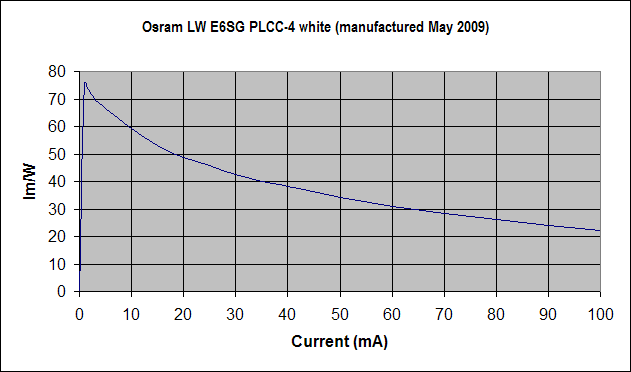Special thanks to jtr1962 for sending me a few samples of this LED to test. Next to an ordinary 5mm LED, you can see it is very tiny.

You can read more about this in jtr1962's "white LED lumen testing" thread. I really like the neutral white ~5,500K light from it. Of course, in this tiny surface mount form factor, it has a very wide beam and is best suited for strip lights or back lighting (such as the intrument cluster in cars). At over 25 ma I recommend heat sinking as the tiny form factor can't dissipate heat all too well. It is designed to operate at up to 50 ma continuously.
Abuse time! I soldered thin 3" copper wires to the leads so that I could plug it on to my test board. I it was driven at around 39ma, so the LED ran warm. Near the end of the test after taking a measurment, I made a mistake and plugged it on the wrong pin of my LM317 in current regulation mode. I was alerted moments later when the LED started to blink! As it turns out, it was getting 150ma and sent the tiny LM317LZ (in TO-92 package) into thermal shutdown mode. It got about a minute of this abuse. After that, I let it run for another 24 hours at 39ma before taking the last light meter reading at 20ma. Results indicate that is a good LED and it was purchased off of ebay believe it or not.
After that, I let it run for another 24 hours at 39ma before taking the last light meter reading at 20ma. Results indicate that is a good LED and it was purchased off of ebay believe it or not.

Yaxis=Light output Xaxis=hours
Odd stuff: The cathode is marked by a bevel in the data sheet, but is in a different position on my samples. Datasheet also claims there is an ESD protection diode, but I did not get any current flow in reverse bias. Are these fakes? I don't know. jtr's tests seems to match the datasheet and I find them to be stable after my abuse.

You can read more about this in jtr1962's "white LED lumen testing" thread. I really like the neutral white ~5,500K light from it. Of course, in this tiny surface mount form factor, it has a very wide beam and is best suited for strip lights or back lighting (such as the intrument cluster in cars). At over 25 ma I recommend heat sinking as the tiny form factor can't dissipate heat all too well. It is designed to operate at up to 50 ma continuously.
Abuse time! I soldered thin 3" copper wires to the leads so that I could plug it on to my test board. I it was driven at around 39ma, so the LED ran warm. Near the end of the test after taking a measurment, I made a mistake and plugged it on the wrong pin of my LM317 in current regulation mode. I was alerted moments later when the LED started to blink! As it turns out, it was getting 150ma and sent the tiny LM317LZ (in TO-92 package) into thermal shutdown mode. It got about a minute of this abuse.

Yaxis=Light output Xaxis=hours
Odd stuff: The cathode is marked by a bevel in the data sheet, but is in a different position on my samples. Datasheet also claims there is an ESD protection diode, but I did not get any current flow in reverse bias. Are these fakes? I don't know. jtr's tests seems to match the datasheet and I find them to be stable after my abuse.
Last edited:


